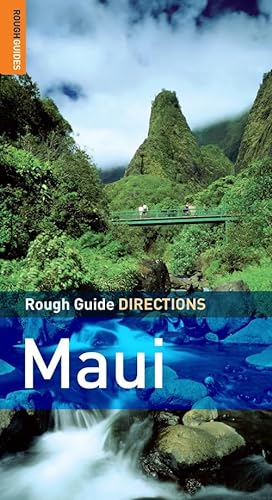Rough Guide Directions Maui - Softcover

"synopsis" may belong to another edition of this title.
Because the tradewinds throughout Hawaii blow consistently from the northeast, each island is much wetter on its north and east – windward – coasts, which are characterized by steep sea cliffs, inaccessible stream-cut valleys, and dense tropical vegetation, and has a drier and less fertile aspect on the west and south – leeward – sides. Maui is somewhat exceptional, in that each of its two distinct volcanoes has its own wet and dry sides. Nonethless, like its neighbors, Maui has concentrated almost all of its tourist development on its sunbaked leeward shorelines, with its major resorts either lying north of historic Lahaina in West Maui, like Ka ‘anapali and Kapalua, or along the southwestern flanks of Haleakala in what’s known as South Maui, like Kihei, Wailua and Makena. These resorts offer safe sandy beaches, ideal conditions for watersports, and all the amenities the modern holiday-maker could ask for. However, there’s plenty to explore elsewhere on the island should you become tired of endlessly meandering between beach and brunch. To get a sense of Maui’s history, the best place to start is strolling the streets of old Lahaina, once the capital of Hawaii and the rendezvous for the wild-living Pacific whaling fleet. The central isthmus or "neck" of the island, between the volcanoes, holds Kahului, the main commercial center, and the faded but somehow appealing town of Wailuku, standing guard over the once-sacred ‘Iao Valley.
To the east, Upcountry Maui, on the lower slopes of Haleakala, is an unexpected idyll, its cool green meadows and flower farms offering a pastoral escape from the bustle below. Higher up, beyond the clouds, you can look out across the many-hued volcanic wasteland of the vast Haleakala Crater, or dwindle into cosmic insignificance by hiking down into it.
Tortuous, demanding roads wind right around the windward coasts of both halves of the island. The better known of the two, the road to Hana in the east, does not quite merit its legendary status, but its countless waterfalls and ravines make for a wonderful day-trip, culminating at lush ‘Ohe‘o Gulch. West Maui’s equivalent, Kahekili Highway, enables visitors to explore the remote Waihe‘e Valley, and offers a glimpse of how Maui must have looked before the tourists arrived.
CLIMATE AND WHEN TO GO
Although Maui’s high season for tourism is mid-December to March, when typical room rates rise by perhaps $25 per night, its climate remains pretty constant year-round.
Throughout the year, sea-level thermometers rarely drop below the low seventies Fahrenheit (around 22°C) in the daytime, or climb beyond the low eighties (around 28°C); at night the temperature seldom falls below the low sixties. The only reason to bring warm clothing is if you plan to drive up to the summit of Haleakala; at dawn, the most popular time to visit, temperatures regularly drop below freezing point. In principle the rainiest months are from December to February, but where you are on the island makes far more difference than what time of year it is, and the main leeward tourist areas seldom receive more than the occasional light shower even then. The highest peak, in the West Maui Mountains – a place you almost certainly will never glimpse, let alone visit – is deluged by over 400 inches of rain per year, but all the coastal resorts, including Ka‘anapali, barely five miles away, get less than twenty inches.
The only seasonal variation of any great significance for tourists is the state of the ocean. Along protected stretches of the shoreline, you can expect to be able to swim all year round in beautiful seas where the water temperature varies from 75°F to 82°F (24–28°C). Between October and April, however, high surf can render unsheltered beaches dangerous in the extreme, and some beaches even lose their sand altogether. Conditions on specific beaches are indicated throughout this book; see also the "Sea Sports and Safety" section on p.44.
Other factors that might influence the timing of your visit include the annual sojourn of migratory humpback whales in the offshore waters, between late November and late March; the peak season for the flowering trees along the Hana Highway, in June; the blossoming of the extraordinary silversword plants of Haleakala in July and August; and the island’s various annual festivals, as detailed on p.41.
Despite the much-publicized onslaught of Hurricane Iniki on Kauai in September 1992, hurricanes are very rare in Hawaii. Similarly, tsunamis (often erroneously called tidal waves) hit perhaps once every fifty years, generally as a result of earthquakes or landslides caused by volcanic eruptions. Civil defense procedures adopted in such events are posted widely throughout the island.
"About this title" may belong to another edition of this title.
- PublisherRough Guides
- Publication date2008
- ISBN 10 1843539896
- ISBN 13 9781843539896
- BindingPaperback
- Edition number2
- Number of pages192
Buy New
Learn more about this copy
Shipping:
US$ 4.25
Within U.S.A.
Top Search Results from the AbeBooks Marketplace
Rough Guide Directions Maui
Book Description Paperback. Condition: new. New Copy. Customer Service Guaranteed. Seller Inventory # think1843539896

